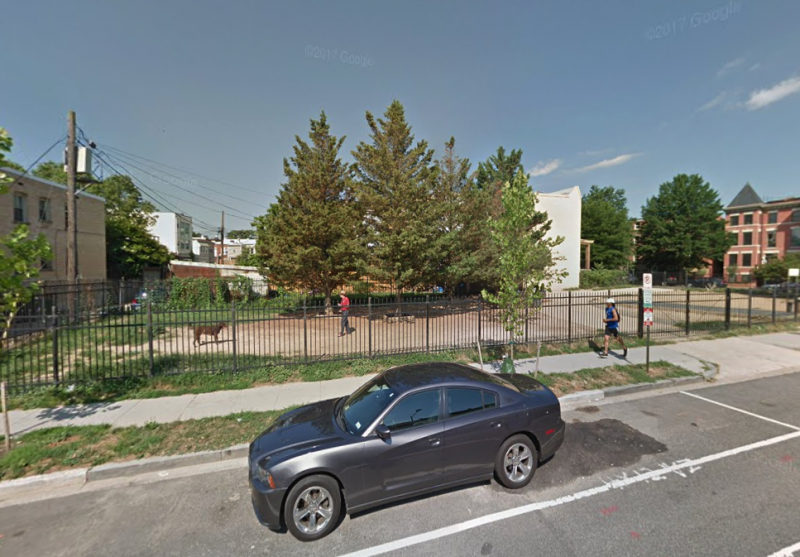Is it unethical to build a dog park on prime real estate in housing-strapped DC?

The 11th and Park parcel, currently used as a dog park. Image created with Google Maps.
Should DC spend about $2 million on a parcel of land in Columbia Heights to build a dog park? The 7,335 square-foot parcel at 11th Street and Park roads NW has been empty for 20 years. It’s owned by WMATA; the Green Line passes under Park Road to connect Columbia Heights to Petworth. Since 2009, WMATA has allowed people (who are largely residents of Columbia Heights) to use the space as a dog park.
WMATA, which still faces budget shortages, is selling surplus land like this parcel to generate more revenue. In May, the DC Council included $1.5 million to purchase the property from WMATA in its FY2019 budget. The market value is estimated to be closer to $2.1 million. Now that it's officially up for sale, dog park users are urging the council to offer to pay the market rate—$2.1 million—to buy the parcel. Bids are due at the end of February.
Alex is writing this with a cat draped across her keyboard, and Nick, though currently petless, has lived with dogs and cats in the past and aspires to own one of each in the future. We agree that pet companionship is a wonderful thing, and that cities should plan for and allocate shared public space for dog-related recreation in appropriate places.
However, in this post we will discuss the moral and ethical implications of what it would mean for a housing-constrained city to dedicate $2.1 million in taxpayer money to favor four-legged recreation on a developable parcel in one of its most central neighborhoods. Despite our affection toward animals, we believe that spending scarce city funds to preserve this particular parcel as as dog park is a bad idea, particularly if there’s any chance of this land being used to build more homes for people.
Building fewer homes makes existing homes more expensive
First, this parcel is zoned MU-4, with up to a 3.0 floor area ratio. It’s part of a stretch of 11th street from roughly Monroe to Kenyon streets that is zoned the same way. The parcel is supposed to be a part of a vibrant, dense, accessible 11th street neighborhood residence and retail corridor. A potential building on the parcel, if built out to approved maximum capacity, could be as much as 50 feet tall, with about 10 or 12 one-, two-, or three-bedroom units.
One weird trick to reduce the high cost of housing in populous metro areas with lots of jobs is to build lots of housing. While this certainly isn’t the only trick to make housing more affordable, it’s a foundational one. It’s one relevant to this parcel, which, given its location, we can reasonably assume might turn into condos or rental units.
Rents in DC have gone down mostly in places where more housing has been built, such as Capitol Riverfront. Recently, all that new construction in Seattle resulted in a 1.1% rent drop from 2017 to 2018. It might be easy to say no to housing over a beloved and well-organized dog park, but saying no to housing puts us on a slippery slope to even more greatly constrained—and even more expensive—market.
This isn't the way to plan a neighborhood, for pets or anything else
Second, though DC’s comprehensive plan has a chapter dedicated to green space, it does not address pets, dog parks, or dog ownership. Perhaps it should! Accounting for pet-centric public space should be considered as a broader governance reform.
If people want accommodations for pets, they should lobby their councilmembers not for a one-time, very expensive land acquisition to preserve something that was never intended to permanently be a dog park, but to including planning for pets in the city’s myriad development-review processes. Situations like this shouldn’t be dealt with ad-hoc.
Pets are important, but they're not more important than humans
Third, even in a world where pets are happily accounted for in the planning process, it’s still worth interrogating why we react so strongly and passionately to a dog park under threat. This isn't an isolated incident: some Eckington residents were frustrated that so much money went to a dog park as part of the Eckington Park development deal.
It's useful to consider the land-use impacts of dog ownership from a critical perspective, just like how GGWash often critically considers the allocation of parking space for automobiles. Parking is often treated as a right, even though driving is dangerous, bad for the environment, and incompatible with walkability.
Dogs are wonderful creatures and are vital for people with certain disabilities and health needs. But in general, favoring them when there’s the potential to demand homes for people is reflective of a suburban and rural norm, not that of a city.
The 11th and Park intersection is 1.1 miles away from the Upshur dog park, and one mile away from Rock Creek Park. If DC, and the region, wasn’t faced with a deep affordable-housing shortage that’s driven largely by a lack of homes both subsidized and market-rate, there would be no problem with preserving “11th and Bark.” Right now, the site is merely up for sale, so what it will be is not yet determined.
A fabulous, fur-friendly future for this intersection would be housing—preferably subsidized, capital-A affordable housing—alongside a place for pets. But that’s not what’s being asked for by dog-park denizens. Spending $2.1 million to preserve a luxury good, when there’s great potential for more homes for people, is an inappropriate rallying cry.
